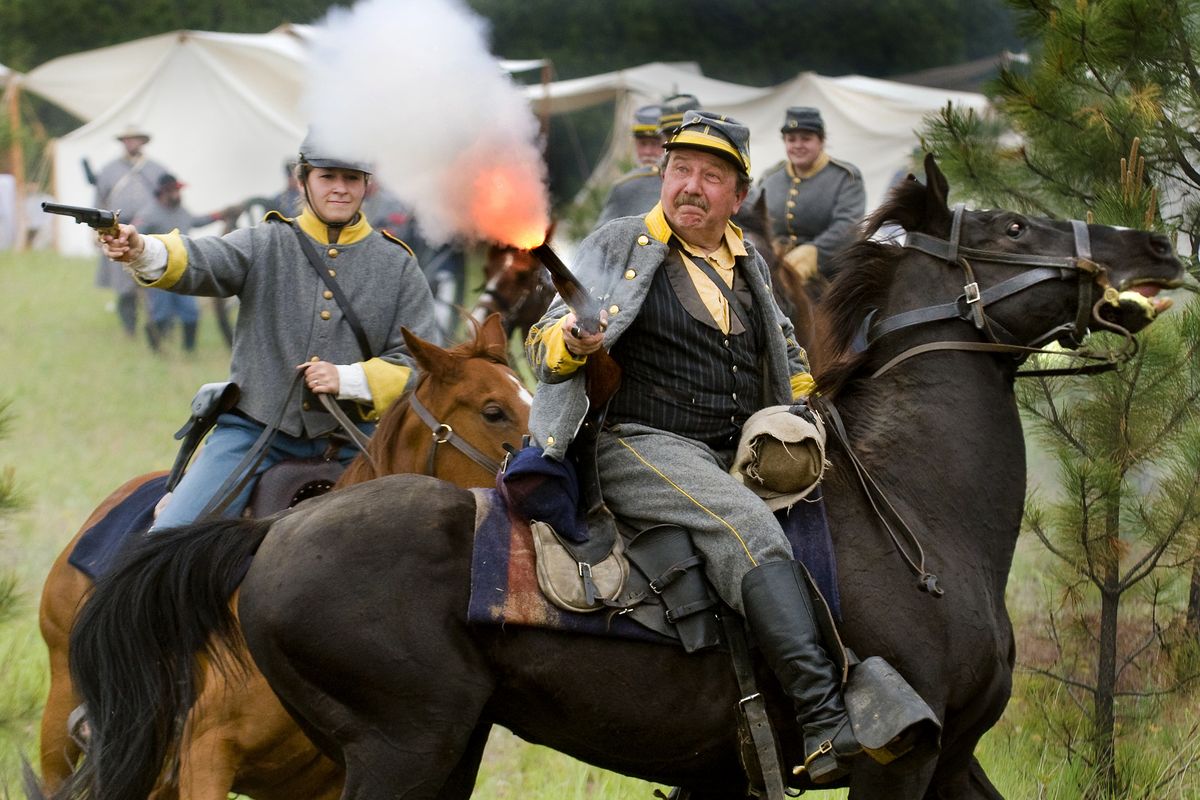Engaged with history
Civil War buffs not past embracing learning, and for some it’s legacy

According to historical accounts, the Battle of Chickamauga spelled one of the most significant Union defeats in the American Civil War.
Fought in northwestern Georgia in September 1863, the casualty count was the second highest in the war, following the battle at Gettysburg.
But on Saturday afternoon, as members of the Washington Civil War Association re-enacted the bloody carnage of Chickamauga on the grounds of Spokane’s Riverside State Park, the favor was with the Union, as Confederate soldiers retreated.
Unlike the real battlefields of America’s bloodiest war – 620,000 were killed – generals for the historical re-enactment held in Spokane each Memorial Day weekend get together every morning and decide who is going to win.
“The Confederate won in the (Saturday) morning battle,” said Jenni Frankovic, 27. “So the Union wins in the afternoon.”
But none of the battles is scripted. The soldiers respond to bugle calls and generals’ orders. They march to “by files left” and other orders, seeing how the conflict plays out.
“We try to make it a very organic experience,” Frankovic said.
Re-enacted twice daily Saturday and today, and once on Monday, the battles are part of the Battle of Spokane Falls, the weekend-long living history encampment and Civil War re-enactment sponsored by the WCWA, the nonprofit organization “committed to honoring our ancestors, both North and South, who fought in or lived during the American Civil War.”
Most of the re-enactors travel with their families, living in canvas tents like soldiers did in camp, and the civilians who followed to help them. They wear period dress and follow cultural rules of the time. You won’t find an unescorted woman in the Union camp, for example.
“We try very hard to be in period all weekend,” said Alfred Myers, chairman of the WCWA. The camps are authentic down to the furniture, canvas tents and wooden crates. The only things that aren’t entirely “period” are perhaps the food preparation and sanitation; there was a bottle of hand sanitizer, a can opener, plastic potato mashers and a plastic tube of mustard lying on the table in one kitchen.
“Most of the soldiers died of dysentery and disease – obviously we aren’t going to re-enact that,” he said. “We aren’t hanging our meats.”
Myers considers himself a Confederate, and rarely fights with the Union, although members are free to pick either side.
“We have guys that will fight for both sides. As a club we don’t mandate which side you pick,” Myers said.
Most soldiers and supporters pick a side based on their opinions and political beliefs.
“I agree more with the South. One of the main reasons the South was fighting was for states’ rights,” and not just for slavery, he added.
Frankovic, a history teacher from the Tri-Cities, stays true to the South because her great-great-grandfather served in the Confederate Army and died at Shiloh.
Frankovic has been participating in re-enactments with her family since she was 14. She’s died in battle – despite the fact that women were not allowed to fight. (If they did fight, and were discovered, they were kicked out.) She’s been a widow in mourning. On Saturday she served as one of the civilian women who cooked, cleaned and did laundry for the soldiers in camp.
“The kids who grew up here, doing this with their families, sometimes they know the history better than their teachers or historians,” Frankovic said.
“It’s a wonderful thing to learn by doing,” said Betty Russo, of Battle Ground, Wash.
Russo, who was preparing fried chicken, potatoes and corn for the men of the 26th North Carolina infantry, considers herself a true Southern woman raised in the ways of the Old Dominion.
Her allegiance, she said, lies with the South. Her family arrived in Jamestown in the 1620s and eventually moved to Texas from Virginia.
“This is a really important legacy to pass on,” Russo said. “This is such an important part of our history, and what better way to learn than to live it.”